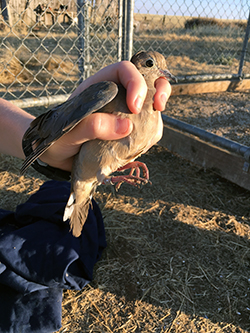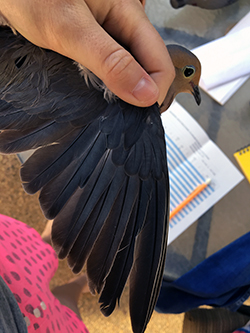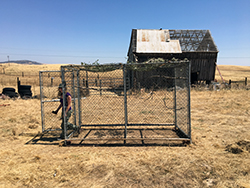CDFW Seasonal Aid Katie Schroyer determines the age of a dove by examining its wing

A banded mourning dove at a CDFW trap site in northern California

Age and sex data are recorded before the bird is banded and released.

A large kennel trap can catch more than 30 birds at a time.
As the second half of California’s split dove season kicks off, dove hunters may put more than birds in their bags. They may harvest a bird with a band on its right leg – thus getting an opportunity to contribute important data that will help guide future management efforts.
Since 2003, California has been an active partner in a nationwide assessment of mourning dove populations. California is one of 39 states that currently participate in dove banding. During the months of July and August, trained biologists and volunteers trap and band doves throughout the state. The banding of migratory birds requires a Master Banding Permit issued upon approval of a study application by the U.S. Geological Survey. All banders must pass an annual training to participate and are then issued a sub-permit.
Mourning doves are so widely distributed that banding operations can be – and are – located almost anywhere, from rural locations to urban backyards. Larger operations located on Wildlife Areas, ranches and open desert sites may employ the use of a large kennel trap capable of trapping 30 or more birds at a time, while smaller operations (“backyard banders”) use small Kniffin traps that catch just one or two birds at a time.
When a bird is banded, age and sex data are recorded. This information, along with capture location, date, bander name and corresponding band number, becomes part of a massive database managed by the USGS’s  Bird Banding Laboratory. The mourning dove banding data is available to any interested party, but is mainly used by the
Bird Banding Laboratory. The mourning dove banding data is available to any interested party, but is mainly used by the  U.S. Fish and Wildlife Service (PDF), university scientists and state agency scientists to analyze and estimate annual survival, harvest rates, recruitment and abundance.
U.S. Fish and Wildlife Service (PDF), university scientists and state agency scientists to analyze and estimate annual survival, harvest rates, recruitment and abundance.
The resulting analysis is used by wildlife managers in setting annual hunting regulations. For instance, in 2015, the USFWS increased the take of mourning doves in the Western Management Unit (which includes the states of California, Oregon, Washington, Idaho, Nevada, Utah and Arizona) from a daily bag limit of 10 to 15. The California Fish and Game Commission followed suit, also increasing the possession limit from two to three times the daily bag limit, in order to accommodate hunters on multi-day hunting trips.
If you harvest or find (encounter) a banded bird, CDFW asks that you report the number directly to the Bird Banding Laboratory. This can be done online at  www.reportband.gov, or by calling (800)327-2263. When reporting an encounter you will be asked for the band number and basic information about where and how you obtained the band.
www.reportband.gov, or by calling (800)327-2263. When reporting an encounter you will be asked for the band number and basic information about where and how you obtained the band.
The person reporting is allowed to keep the band, and will receive a certificate with the details about where, when and by whom the bird was banded.
The USGS Bird Banding Lab is the keeper of banding data for both the US and Mexico. As of September 18, 2017 and since 1960, the BBL has received over 64 million banding records. Since the inception of the North American Bird Banding Program, the BBL has received over 4 million encounter records. On average, over the past decade, the BBL received 1.2 million banding and 87,000 encounter records per year.
For more information about mourning dove banding, including the 2017 Mourning Dove Harvest Strategy, visit the  Doves and Pigeons page on the FWS website.
Doves and Pigeons page on the FWS website.
CDFW photos by Kloey Helms
Featured photo: CDFW Seasonal Aid Katie Schroyer determines the age of a dove by examining its wing.